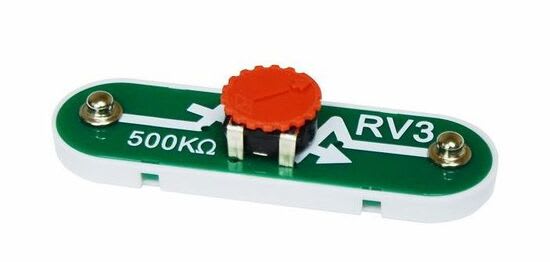The kids got a Snap Circuits Kit a while ago, and enjoy it. In terms of learning, however, it's been a bit mixed. The basic circuits (light, motor) are good: they understand they need to connect the parts the right way around and that they need a complete circuit. On the other hand, most of the projects in the kit rely on the three audio chips, and just doing the projects isn't enough to really understand how they work.
They had a friend over yesterday, and after building one of the projects together wandered off to do something else. I decided to see if I could experimentally determine how one of the chips worked, so that maybe we could do something interesting together later. There turned out to be a lot more combinations that did something interesting than I expected, however, so instead this is just cataloging them. So: here are 13 more snap circuits projects you can make that abuse the music IC to do things it wasn't intended to do.
Since none of this is what was intended, you may get different results from these than I did. I think you won't break anything, because as a modern kids toy I'd expect this to be robust to hooking it up 'wrong', but no guarantees.
First, though, here's the basic correct operation of the Music IC:
The pinout of the chip is:
trigger +--+--+ hold
| |
- +-----+ out
The idea is you connect positive voltage to the + pin,
negative to the - pin, run the speaker between
out and + and you'll get "happy birthday".
It plays one time through the song when it first gets power, and
repeats if you connect trigger to power momentarily or
hold to power in a sustained way.
Despite my picture above being the simplest correct use of the chip, it's not one of the projects. Instead the first project with an audio IC (#3) also includes the "whistle chip" sensor on the trigger pin to allow you to make it start over. Then they follow up (#4) by putting a resistor in series with the speaker to make it quieter.
Here are some other arrangements that demonstrate other modes the chip has:
Instead of connecting
+directly to positive voltage, put the resistor in the way. It plays the same song at a slightly lower pitch.Don't connect anything to
+. Instead, connect positive voltage tohold. It plays something kind of of like a distorted version of the first line.Same as (2) but use the resistor instead of a jumper. It makes an annoying electronic alarm noise.
Put the LED from positive to
holdand the momentary switch from positive to+. Tapping the switch gives a ray gun sort of chirp.Same as (3) but add the momentary switch from positive to
+. Initially it plays the annoying alarm, but when you tap the switch it plays a cross between the song and the alarm noise.Same as (1) but also add a jumper from positive voltage to
holdand the LED from-to negative voltage. It plays a quiet buzzer sound.Same as (6) but use the lamp instead of the LED. It plays the song in a stuttery uneven staccato way.
Same as (2) but put the resistor from
-to negative voltage. It sometimes plays a quiet chirping like a phone that has been left off the hook, other times more like a robotic bird call.Same as (8) but put the jumper from positive to
+instead of positive tohold. It moves through a range of annoying buzzing at different pitches.Same as (2) but with the resistor in series with the speaker. It plays something very similar to (7).
Same as (10) but without the jumper from positive to
holdand with the photoresistor from positive to+. Makes a range of annoying squeals. ("Like an alien invasion attacking our house")Make a circuit from the positive terminal through the speaker through the
+to-and then the negative terminal. It plays happy birthday very quietly. Same thing if you put the speaker on the negative side, or even in parallel with the battery!Make a circuit from the positive terminal through the speaker through
holdtooutto the negative terminal. Plays something quiet and distorted that seems like it might have been music once.
For example, here is (11):
Most of these combinations, and the ones that make the most interesting sounds, are essentially adding resistance in places where it wasn't designed for. The 100Ω resistor, LED, light, and diode all provide different amounts of resistance. This is clearest with the photoresistor, where by shining a bright light on the sensor and then dimming it you can move it through all of these modes. I think this would be even better with an adjustable resistor, but while the manufacturer does make one it's not included in the starter kit.
After writing the above, Anna (7y) and I went through most of these combinations. She especially liked using a flashlight to move between states with the photoresistor. We tried to build variable resistors out of household objects, but didn't have much success: a pencil cut in half was too low resistance, a thick line drawn with pencil was too high, slightly salted water wasn't close to linear.

